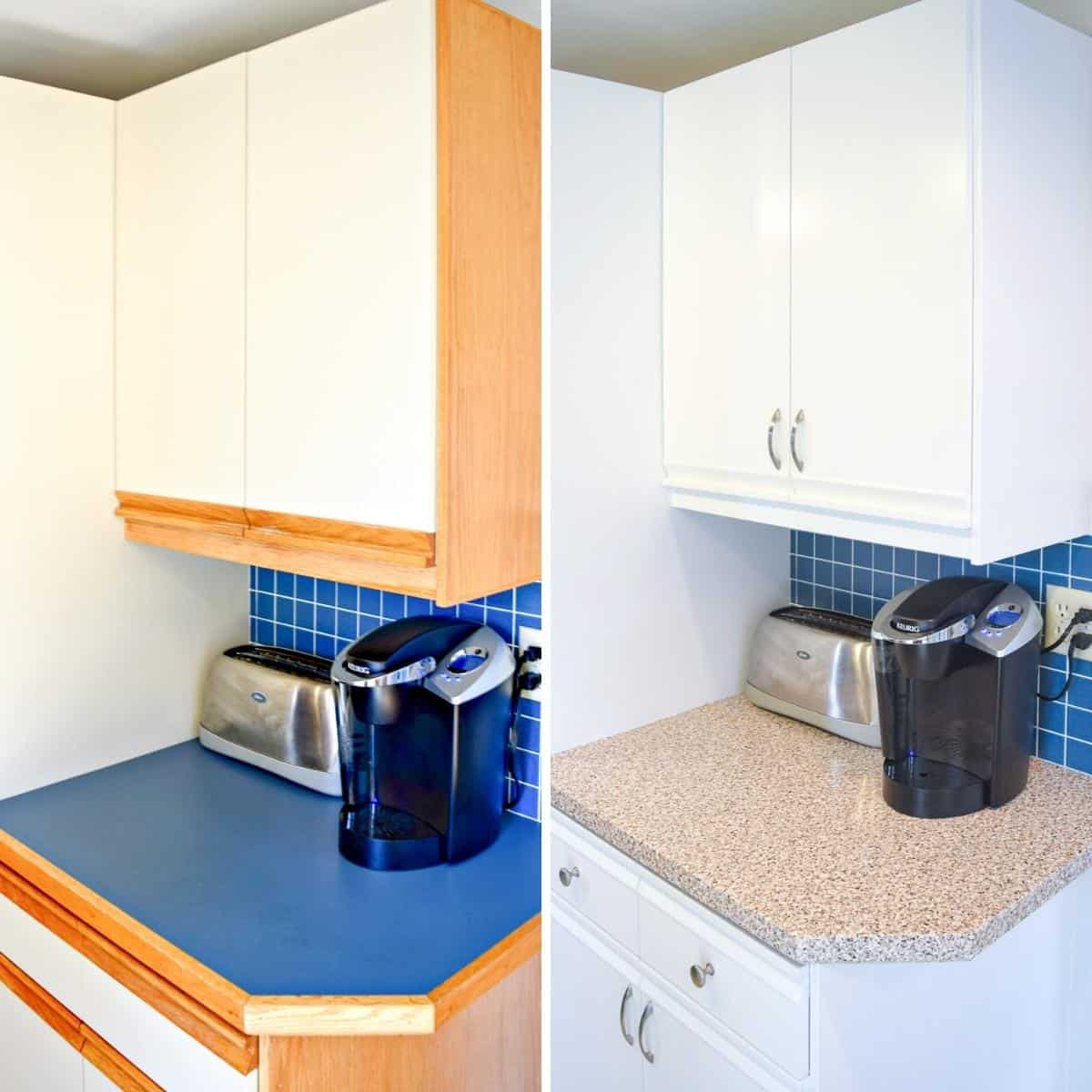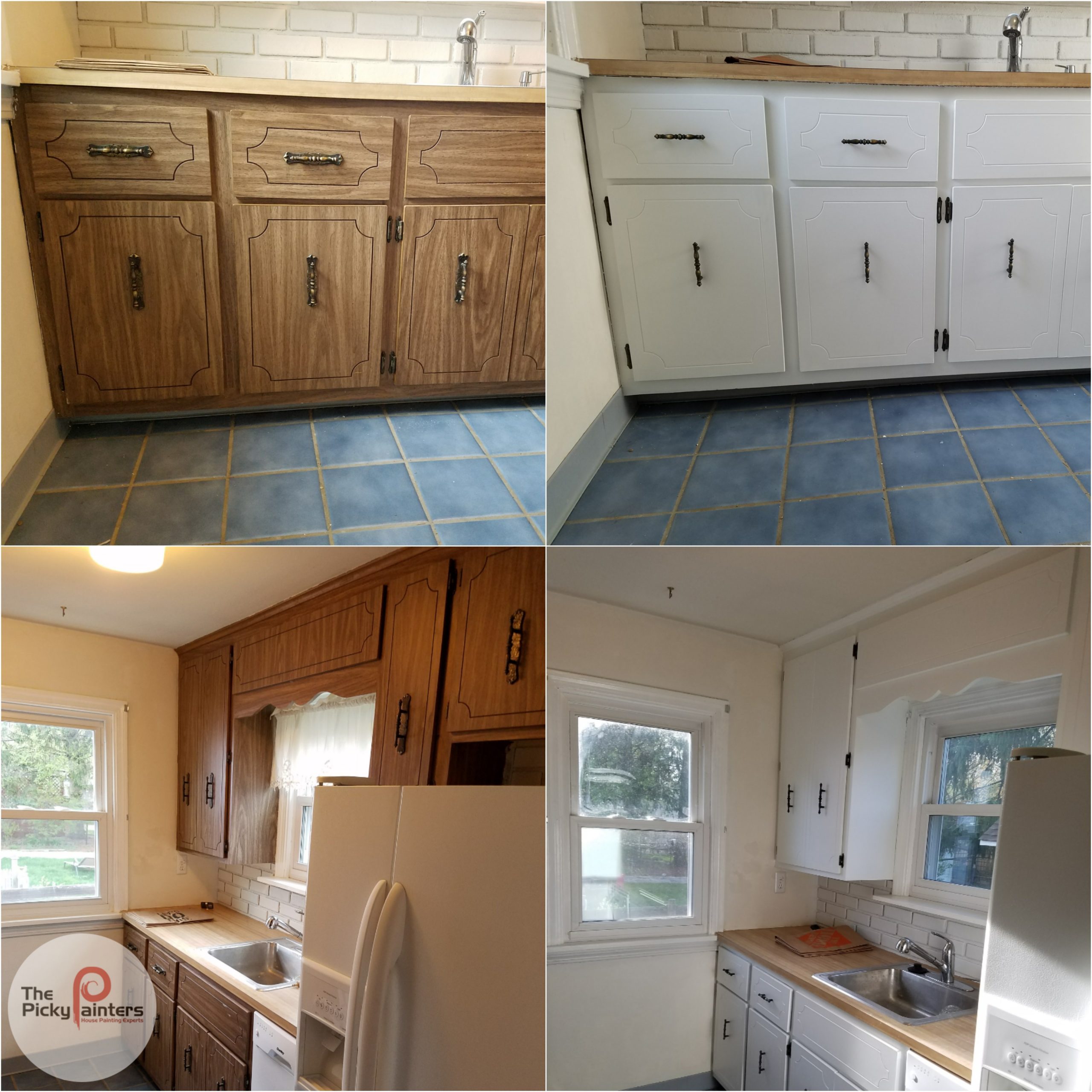Preparing Laminate Cabinets for Painting

Painting laminate cabinets can give your kitchen a fresh, updated look. However, laminate surfaces are notoriously difficult to paint due to their smooth, non-porous nature. To ensure your paint adheres properly and lasts, thorough preparation is essential. This involves cleaning and sanding the laminate to create a surface that the paint can grip onto.
Cleaning Laminate Cabinets, How to paint laminate cabinets
Cleaning your cabinets is the first step in preparing them for painting. This removes any dirt, grease, and grime that could interfere with paint adhesion.
- Start by wiping down the cabinets with a damp cloth and mild dish soap. This removes loose dirt and grime.
- For stubborn stains, use a degreaser or a mixture of baking soda and water. Apply the cleaner to a cloth and scrub the affected areas gently.
- Rinse the cabinets thoroughly with clean water to remove any soap residue.
- Allow the cabinets to dry completely before moving on to the next step.
Sanding Laminate Cabinets
Sanding laminate cabinets creates a rougher surface that the paint can adhere to. This is crucial for achieving a durable and long-lasting paint job.
- Use a fine-grit sandpaper (120-grit or higher) to lightly sand the entire surface of the cabinets.
- Sand in the direction of the wood grain to avoid creating scratches.
- Don’t sand too aggressively, as you don’t want to damage the laminate. The goal is to create a slightly rough surface, not to remove the laminate entirely.
- After sanding, wipe down the cabinets with a tack cloth to remove any dust particles.
Essential Tools and Materials
To prepare your laminate cabinets for painting, you’ll need the following tools and materials:
- Mild dish soap
- Degreaser (optional)
- Baking soda (optional)
- Tack cloth
- Fine-grit sandpaper (120-grit or higher)
- Sanding block (optional)
- Paint scraper (optional)
- Drop cloths
- Gloves
- Safety glasses
- Paint primer
- Paintbrush or roller
Choosing the Right Paint and Primer: How To Paint Laminate Cabinets

Painting laminate cabinets can be a great way to update your kitchen or bathroom without a full remodel. However, laminate surfaces are notoriously difficult to paint because they are smooth and non-porous. Choosing the right paint and primer is crucial for a successful paint job that will last.
Understanding the Importance of Primer for Laminate Surfaces
Primer is essential when painting laminate cabinets because it creates a bond between the paint and the smooth, non-porous surface. Without a primer, the paint will likely chip or peel. A primer also helps to cover any imperfections or stains on the laminate surface, creating a smooth, even base for the paint.
Different Primer Options for Laminate Cabinets
- Adhesion Primer: This type of primer is specifically designed to adhere to slick surfaces like laminate. It creates a rough texture that allows the paint to grip more effectively.
- Epoxy Primer: This primer is known for its durability and resistance to moisture. It is a good choice for kitchen cabinets that will be exposed to spills and splashes.
- Oil-Based Primer: This type of primer offers good adhesion and durability, but it can be more difficult to clean up than water-based primers.
Choosing the Right Paint for Laminate Cabinets
- Acrylic Latex Paint: This is a popular choice for painting laminate cabinets because it is durable, easy to clean, and dries quickly. Acrylic latex paint also offers good coverage and comes in a wide range of colors.
- Epoxy Paint: Epoxy paint is highly durable and resistant to moisture, making it a good choice for kitchen cabinets that will be exposed to spills and splashes. However, epoxy paint can be more difficult to apply than acrylic latex paint.
- Oil-Based Paint: Oil-based paint offers excellent durability and a smooth finish, but it can be more difficult to clean up than water-based paint and may take longer to dry.
Tips for Choosing the Right Paint Color and Finish
- Consider the Existing Decor: Choose a paint color that complements the existing decor in your kitchen or bathroom. You can use a color wheel to help you find harmonious color combinations.
- Choose a Durable Finish: For kitchen cabinets, a semi-gloss or gloss finish is a good choice because it is easy to clean and resistant to stains. For bathrooms, a satin finish is a good option because it is less reflective than gloss.
- Test the Paint: Before you commit to a paint color, test it out on a small area of the laminate surface. This will help you see how the color looks in your space and how well it covers the laminate.
Painting Laminate Cabinets

Now that your cabinets are prepped and ready, it’s time to get painting! This is the fun part, but remember, a good paint job requires precision and patience.
Painting Techniques
Applying paint to laminate surfaces requires a slightly different approach than painting wood. Here’s how to get a professional-looking finish:
- Choose the Right Brush: Opt for a high-quality angled brush for painting cabinet doors and drawers. The angled bristles help you reach corners and edges easily, ensuring even coverage. For larger surfaces, consider using a roller with a nap length suitable for smooth surfaces.
- Thin Your Paint: To achieve a smooth, even finish, it’s recommended to thin your paint slightly. This makes the paint flow more easily, reducing the risk of brush strokes. Follow the manufacturer’s instructions on the paint can for the correct thinning ratio.
- Apply Thin Coats: Multiple thin coats of paint are better than one thick coat. Each coat should be applied evenly, allowing sufficient drying time between coats. This approach helps prevent paint drips and ensures a smooth, even finish.
- Use Long, Even Strokes: When using a brush, apply paint with long, smooth strokes, following the direction of the wood grain. This helps prevent brush marks and ensures a uniform finish.
- Don’t Overlap: Avoid overlapping wet paint. This can cause paint to build up, leading to uneven coverage and brush strokes.
- Clean Up Immediately: Clean your brushes and rollers immediately after use. Use a paint thinner or solvent recommended by the paint manufacturer.
Avoiding Common Painting Imperfections
Painting laminate can be tricky, but with a few simple techniques, you can avoid common imperfections:
- Sanding: Light sanding between coats helps to smooth out any imperfections and create a smoother finish. Use fine-grit sandpaper and sand gently in the direction of the wood grain.
- Tack Cloth: After sanding, use a tack cloth to remove dust particles. This will ensure a clean surface for the next coat of paint.
- Brush Strokes: Avoid leaving visible brush strokes by using a light touch and applying paint in long, even strokes. If you do notice brush strokes, you can lightly sand them down after the paint has dried.
- Paint Drips: To prevent drips, don’t overload your brush with paint. If you do have a drip, clean it up immediately before it dries.
Applying Multiple Coats of Paint
For optimal coverage and durability, applying multiple coats of paint is essential.
- First Coat: The first coat of paint serves as a primer, providing a base for subsequent coats. Apply a thin, even coat, allowing it to dry completely before applying the next coat.
- Second Coat: The second coat of paint will build on the first coat, providing greater coverage and color depth. Again, apply a thin, even coat and allow it to dry completely before moving on.
- Third Coat: A third coat of paint is usually sufficient for most laminate surfaces. This coat will enhance the overall finish and ensure a smooth, durable surface.
How to paint laminate cabinets – Painting laminate cabinets can be a fantastic way to give your kitchen a fresh look, and you can even add a touch of timeless elegance by incorporating roman arch cabinet doors. These doors, with their graceful curves, can elevate any cabinet style.
Just remember to prep the laminate surface thoroughly before painting for a flawless finish that will stand the test of time.
Painting laminate cabinets can be a fun and rewarding project, but it’s essential to prepare your space properly. Before you get started, consider the lighting in your work area. Just like creating a relaxing sleep environment requires turning off the lights in the bedroom , having ample, well-placed lighting for your cabinet project will make all the difference in achieving a smooth and even finish.
